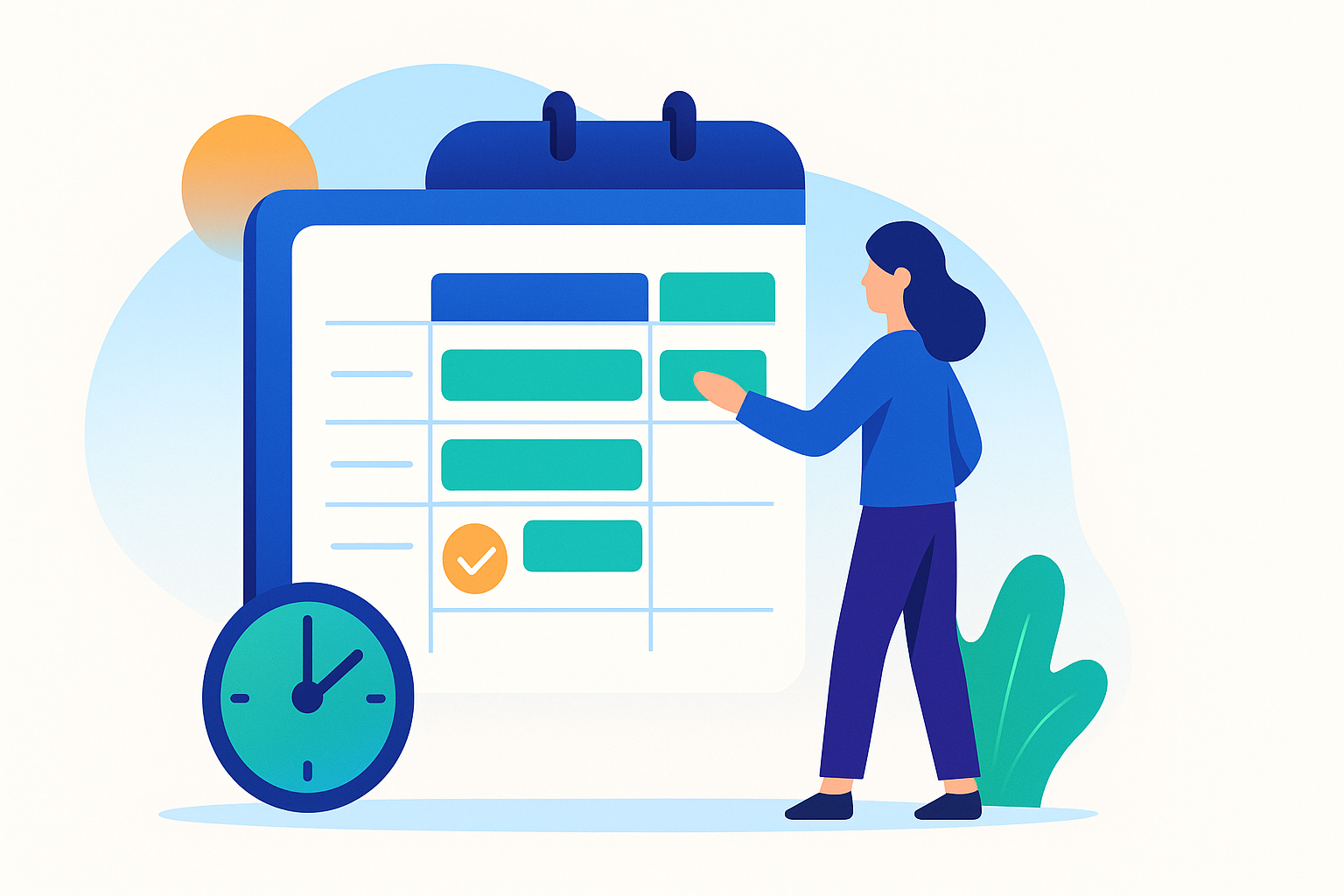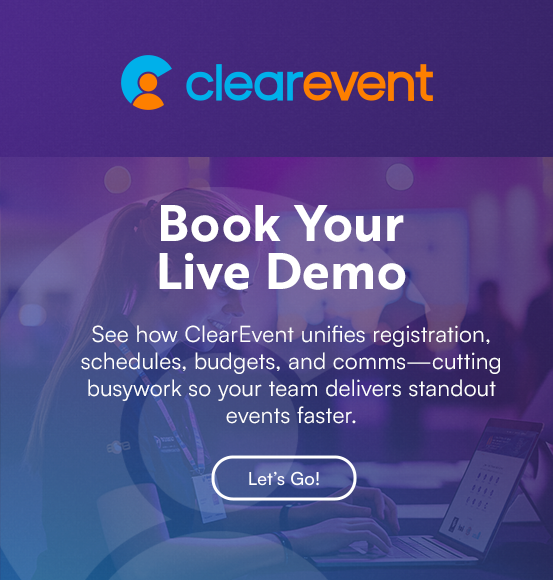Ultimate Guide to Managing Multi-Day Conference Schedules

Planning a multi-day conference schedule can feel overwhelming, but it’s also the key to a smooth event and satisfied attendees. Overlapping sessions, crowded rooms, or last-minute speaker changes quickly create frustration and poor reviews. Smooth event registration and scheduling help set the tone for an organized, stress-free experience. Whether you’re a small team juggling logistics or a seasoned organizer running back-to-back events, the right schedule makes all the difference. With the right strategies and event scheduling software, you can avoid those pitfalls and deliver a seamless experience.
Creating Your Conference Schedule
A well-organized schedule helps attendees get the most out of your event while reducing stress for organizers. Here’s how to make it happen:
Set Clear Daily Agendas
Each day should start strong and stay consistent. Consider this structure:
- Morning Power Hours: Kick off with inspiring keynotes or workshops to energize participants.
- Regular Breaks: Build in breaks for networking, refreshments, and recharging.
- Afternoon Variety: Offer interactive sessions to keep interest high.
- Buffer Time: Add short transition periods to absorb delays without throwing the schedule off.
Pro Tip: Attendees appreciate predictability. Publish your daily schedule in advance and stick to consistent start and end times wherever possible.
Mix Session Types
Different formats keep people engaged and cater to varied learning styles. Consider including:
- Keynotes for inspiration
- Hands-on workshops for practical skills
- Panel discussions for diverse perspectives
- Networking blocks for connection
Mixing formats keeps your agenda dynamic and prevents attendee fatigue.
Manage Multiple Tracks With Clarity
If you’re offering parallel sessions, clarity is everything. To streamline conference schedule management:
- Use color-coding, track labels, or tags to help attendees navigate
- Keep time blocks consistent across all tracks
- Avoid scheduling similar topics head-to-head
- Apply buffer times uniformly across all tracks
Make Digital Tools Your Secret Weapon
Digital solutions simplify multi-day conference planning for both attendees and organizers.
What to Look for in Scheduling Tools
When evaluating easy-to-use scheduling tools, focus on features that directly support your team and your attendees:
- Schedule Creation: Multi-track support, conflict detection, room management
- Attendee Experience: Personalized agendas, mobile access, real-time updates
- Organizer Control: Quick edits, centralized calendar, schedule freezing
- Communication: Notifications, content sharing, and integrated messaging
These features save small teams countless hours and ensure nothing slips through the cracks.
Perfecting Session Timing and Flow
How Long Should Sessions Be?
Research shows attention spans taper after 60–90 minutes. Aim for:
- In-person sessions: 60–90 minutes with a 15–30 minute break
- Virtual sessions: 45–60 minutes with shorter breaks plus stretch time
Pro Tip: Use no more than 70% of each session for content delivery. Leave the rest for Q&A, discussions, or interactive activities.
Prevent Scheduling Conflicts
To keep your event running smoothly:
- Centralize all scheduling in one tool to avoid double-bookings
- Factor in time zones if you have virtual or hybrid sessions
- Maintain a shared event calendar as a single source of truth
- Check for local or industry events that may affect attendance
- Build 15-minute buffers between sessions
Streamline Room and Speaker Transitions
Even the best schedule falls apart if transitions are clumsy. Set yourself up for success by:
- Collecting all presentations at least 24 hours in advance
- Assigning moderators to keep sessions on time
- Using countdown timers or visual cues for speakers
- Preparing backup content (short videos, icebreakers, quick polls) for unexpected gaps
Handling Changes and Updates
Schedule changes are inevitable. The key is communicating them effectively.
Build in Buffer Time
Think of buffer time as your safety net, it absorbs surprises without derailing your agenda. Strike a balance: enough to handle changes, but not so much that it creates downtime or unnecessary costs.
Communicate Updates Clearly
When things shift, attendees should never be left guessing. Best practices:
- Share updates through multiple channels (mobile event app, email, digital signage)
- Provide staff or volunteers at key locations to answer questions
- Let attendees know ahead of time which channels will be used for updates
- Create a two-way feedback loop (chat or help desk) so attendees can report issues quickly
Using Attendee Feedback
Your schedule isn’t just for this year, it’s a blueprint for the future. Collect real-time feedback through mobile surveys, session ratings, or post-event reviews. Afterward, analyze:
- How well sessions stayed on time
- Which types of sessions drew the most engagement
- Where communication gaps occurred
This insight helps you refine your conference agenda software and planning process year over year.
Looking Ahead: The Future of Conference Scheduling
Trends shaping the future of conference schedule management include:
- AI-powered personalization: Tools that recommend sessions based on attendee preferences
- Hybrid and virtual formats: Giving attendees flexibility while extending reach
- Accessibility: Ensuring schedules are inclusive and easy to navigate for all participants
- Real-time analytics: Using live data to adjust sessions and improve outcomes on the spot
The bottom line: well-organized schedules create memorable experiences. Live events continue to drive trust and engagement, with attendees reporting higher confidence in brands after in-person interactions.
Final Takeaways
Effective multi-day conference planning blends technology, structure, and communication. Here are your key reminders:
- Plan at least three months in advance
- Keep sessions between 45–60 minutes, with regular breaks
- Use event scheduling software to centralize updates and reduce stress
- Lean on small team event management tools that make coordination easier
- Always measure engagement and use feedback to improve
With these practices in place, you’ll not only reduce stress for your team, you’ll also deliver an event that attendees remember for all the right reasons.
Start simplifying your multi-day conference planning today with ClearEvent an all-in-one event scheduling software designed for small teams.
Frequently Asked Questions (FAQ)
How do I create a multi-day conference schedule that avoids overlaps? The best approach is to use event scheduling software that automatically flags conflicts and double-bookings. You can also standardize session lengths, apply consistent time blocks, and use color-coded tracks to help attendees navigate.
What’s the ideal session length for conferences? Most attendees can stay focused for 60–90 minutes. Aim for 45–60 minutes of content followed by time for Q&A or interactive activities. Always build in short breaks to keep energy levels high.
How can small teams manage complex conference schedules effectively? Small teams benefit from using easy-to-use scheduling tools that centralize tasks. Features like conflict detection, real-time updates, and attendee schedule builders save hours of manual coordination.
What should I do if last-minute schedule changes occur? Communicate updates quickly across multiple channels—mobile app, email, and on-site signage. Provide clear instructions and offer staff at help points so attendees know where to go. Transparency minimizes frustration.
Why is buffer time important in conference planning? Buffer time acts as a safety net that absorbs delays or unexpected changes without derailing the entire agenda. It keeps the event running smoothly and reduces stress for organizers and attendees alike.
